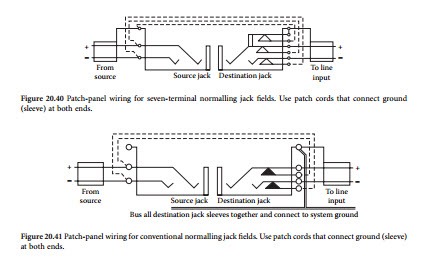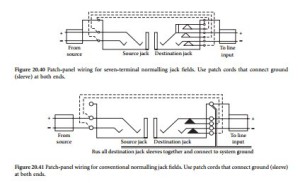Cable Routing
Good engineering practice dictates that different signal levels be grouped and separated from each other. It is common practice to separate cables into the following groups:
• ac power
• Speaker lines
• Line-level audio
• Microphone-level audio
• Video lines
• Control and data lines
Always use two-conductor shielded cable for all audio signal cables. This includes both balanced and unbalanced circuits, and microphone-level and line-level cables. On any audio cable connecting two pieces of equipment, tie the shield at one end only. Connect at the receiving end of signal transmission. On video coaxial cables running to outlet jacks mounted on plates, isolate the connector from the plate. The shield should connect to ground only at the equipment input/output or patch panel. For data cables, carefully follow the recommendations of the equipment manufacturer. The preferred interconnection method for long data cables is fiber optics, which eliminates ground-loop problems altogether.
Overcoming Ground-System Problems
Although the concept of equipment grounding seems rather basic, it can become a major headache if not done correctly. Even if all of the foregoing guidelines are followed to the letter, there is the possibility of ground loops and objectionable noise on audio, video, or data lines. The larger the physical size of the facility, the greater the potential for problems. An otherwise perfect ground system can be degraded by a single wiring error. An otherwise clean signal ground can be contaminated by a single piece of equipment experiencing a marginal ground fault condition.
If problems are experienced with a system, carefully examine all elements to track down the wiring error or offending load. Do not add ac line filters or signal line filters to correct a problem system. In a properly designed system, even one in a high-RF field, proper grounding and shielding techniques will permit reliable operation. Adding filters merely hides the problem. Instead, correct the problem at its source. In a highly complex system such as a data processing facility, the necessity to interconnect a large number of systems may require the use of fiber-optic transmitters and receivers.

